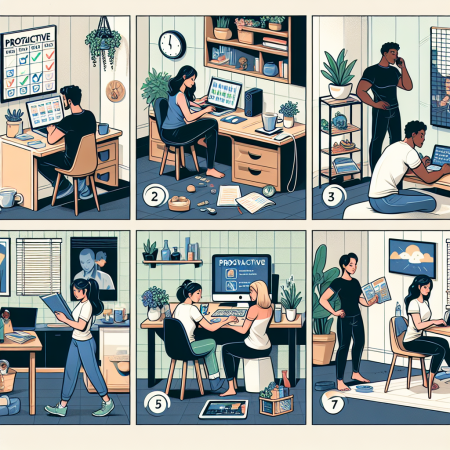7 Habits of Highly Effective Home Workers
Table of Contents
- Creating a Dedicated Workspace
- Maintaining a Consistent Schedule
- Prioritizing Communication
- Embracing Breaks and Downtime
Creating a Dedicated Workspace
Alright, let’s dive into the first key habit – establishing a dedicated workspace. From my own experience, having a specific place where you work can incredibly boost your productivity. Imagine trying to work from your couch, surrounded by distractions. It’s a nightmare, right? That’s why having a designated workspace can act as a boundary, separating your work life from your home life.
When setting up your workspace, consider ergonomics. Comfort is key here. You don’t want to end up with a sore back or strained eyes. Get an adjustable chair, ensure your desk is at a proper height, and if possible, have a window nearby for that natural light boost. These little tweaks can make a huge difference.
Personalizing your space can also uplift your mood and make work less of a chore. Add some plants, pictures, or anything that inspires you. Trust me, a little bit of personality can go a long way in making you feel more engaged and motivated while you work from home.
Maintaining a Consistent Schedule
One of the biggest challenges of working from home is the temptation to deviate from a regular schedule. However, keeping a consistent routine is a game-changer. From my personal journey, I can attest that sticking to regular hours helps sustain your productivity and well-being. Set a start time and an end time, and be strict about it.
Creating rituals to start and end your day can be particularly effective. For example, I kick off my mornings with a cup of coffee and a review of my to-do list. At the end of the day, I like to take a short walk or do some light stretching. These routines help signal to my brain when it’s time to go into work mode and when it’s time to relax.
Don’t forget to allocate time for breaks. Short, regular breaks can help you stay focused and prevent burnout. The Pomodoro Technique, where you work for 25 minutes and then take a 5-minute break, has worked wonders for me. It’s all about finding what fits your rhythm and sticking with it.
Prioritizing Communication
Let’s talk about communication. Working from home can sometimes feel isolating, but keeping the lines of communication open with your team is crucial. From my experience, consistent communication ensures everyone is on the same page and helps build a strong team dynamic, even when you’re miles apart.
Utilize tools like Slack, Zoom, or Microsoft Teams to stay connected. Regular virtual meetings can replace that face-to-face interaction we miss while working remotely. Setting clear expectations with your team about availability and response times also goes a long way in maintaining effective communication.
Transparency is key. Don’t hesitate to share updates on your progress, seek feedback, or ask for help when needed. It keeps everyone informed and fosters a collaborative environment. Remember, over-communication is better than under-communication in a remote setting.
Embracing Breaks and Downtime
I cannot stress enough the importance of taking regular breaks. It’s so easy to get caught up in work and forget to take a moment for yourself. However, from my personal experience, I’ve learned that breaks are essential for maintaining productivity in the long run. They help reset your mind and keep your energy levels up.
Short breaks are great, but also make sure you take a proper lunch break. Step away from your desk, eat something nutritious, and maybe even get some fresh air. It’s about giving yourself permission to relax and recharge.
Downtime isn’t just about breaks; it’s also about knowing when to shut down for the day. Creating a clear boundary between work and personal time can help prevent burnout and keep you feeling refreshed and ready for the next day. Enjoy your evenings, spend time with loved ones, and indulge in hobbies that bring you joy.
Frequently Asked Questions
1. Why is a dedicated workspace important?
A dedicated workspace separates your work life from your home life, minimizing distractions and helping you stay focused. It’s about creating an environment that signals to your brain when it’s time to work and when it’s time to relax.
2. How can I maintain a consistent schedule?
Set specific start and end times for your workday and stick to them. Develop routines to begin and end your day, and use techniques like the Pomodoro Technique to incorporate regular breaks and maintain focus.
3. What are effective ways to prioritize communication?
Utilize communication tools like Slack and Zoom to stay connected with your team. Have regular virtual meetings, set clear expectations, and ensure you are transparent with your updates to maintain a collaborative environment.
4. How do breaks impact productivity?
Regular breaks help reset your mind and prevent burnout, ultimately boosting productivity. Taking breaks, including a proper lunch break, allows you to relax and recharge, leading to better focus and energy for the rest of the day.

